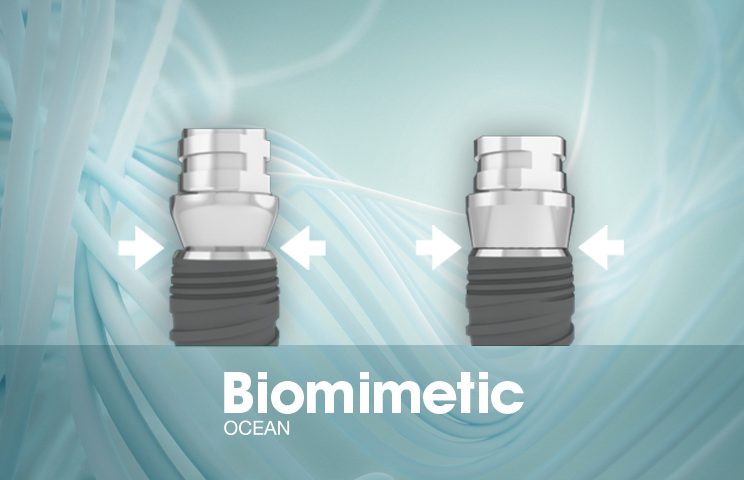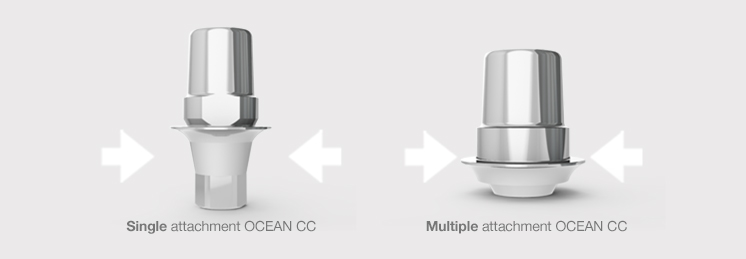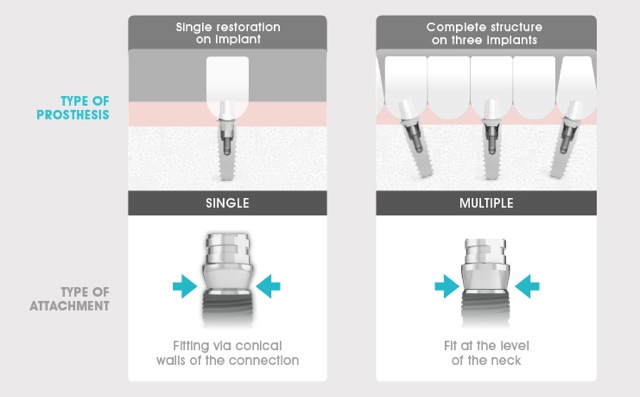

AVINENT’s OCEAN range of implants is well known for its advantages in clinical practice thanks to its innovative geometry, stability and surface, which promotes osseointegration.
Eager to continue making dentists’ work easier, AVINENT devised a new type of connection for this implant system: a conical connection (CC), which takes its place alongside the existing internal (IC) and external (EC) connections. This conical connection was designed to provide greater versatility in all kinds of cases, dealing carefully with the prosthetic part and the shaping of the soft tissue in the same way.
This connection’s prosthetic system has a set of features that make it easier for prosthodontists to obtain optimal emergence profiles in anterior and posterior region cases. There are several reasons for this. First, OCEAN CC has healing abutments with three different diameters (4, 5 and 6 mm). Second, and this is crucial, the conical connection’s prosthetic attachment system offers two different types of design based on the final restoration.

Single and multiple attachment systems
AVINENT has designed two groups of attachments for OCEAN CC that make it easier for dentists to handle prostheses when they are engrossed in planning, placing or maintaining the restorations they perform.
On the one hand, we have single attachments. This abutment design is characterized by perfect adjustment through maximum contact between the surfaces of the attachment and the connection of the implant. It guarantees maximum reliability in terms of stability and reduces implant-prosthesis micromovements. Dr. Pablo Murillo, of Clínica Dental Dr. Pablo Murillo (Zaragoza), stresses his satisfaction with single abutments due to their great fit and precise screwing. “I use OCEAN CC single abutments often, essentially for their stability. The cone fit prevents micromovements and loosening of the abutment, which has a very positive impact on the patient’s health in the end.” Along the same lines, Dr. Enrique Carrera González, of Clínica Carrera (Madrid), adds that “the anti-rotation system makes the fit so much easier. I love how they designed the cone.”



However, these advantages have nuances that must be taken into account when discussing multiple prostheses. When dentists seek maximum passivity on implants placed at different angulations, OCEAN CC offers them another option: multiple attachments. Designed for restorations with more than one implant, these abutments are characterized by their fit at the level of the implant neck. This makes handling simpler and more reliable, more comfortable and less risky. As Dr. Francisco Miravé, of Clínica Dental Miravé (Barcelona) explains, “multiple attachments give you more passivity and let you place the prosthesis even if through different pathways.”

Cases of multiple prostheses with single attachments
There are cases when a set of prosthetic supplements must be used, either because it is the dentist’s ultimate goal or because the prosthesis is already defined by the characteristics of the restoration. On these occasions, dental professionals do not always require multiple attachments strictly to place structures. Thus, we see that restorations with transepithelial abutments or overdentures use a single abutment design for optimal functionality. Therefore, we find that we sometimes need single abutments to successfully treat and put the finishing touch on operations with multiple prostheses, even though it may not seem like it.
Although many dentists feel fully comfortable with single abutments when handling multiple structures, others prefer not to use them unless strictly necessary. Thus, for example, Dr. Murillo says that he always works with single attachments “due to their stability and fit, as well as in multiple restorations.” Dr. Carrera agrees, explaining that “we tend to use angled transepithelial abutments in multiple attachments and the passivity of the prosthesis is always good.” Dr. Miravé, however, prefers to use multiple attachments instead of single ones because, according to his opinion and experience, single ones “limit my movement in positioning the implants too much.” Therefore we see that, to a certain extent, the choice of the type of abutment to use is linked to dental professionals’ preferences and comfort in their daily work.
The variety in the range of OCEAN CC attachments that AVINENT has made available to the dental sector is one more example of the company’s desire to make dentists’ work easier. “OCEAN CC is the future,” says Dr. Pablo Murillo. “We think it is amazing. It works like a charm,” adds Dr. Enrique Carrera. Opinions like these, based on users’ daily experience, encourage AVINENT to keep on investigating and lead the way towards more advanced, intuitive and effective dentistry in the 21st century.